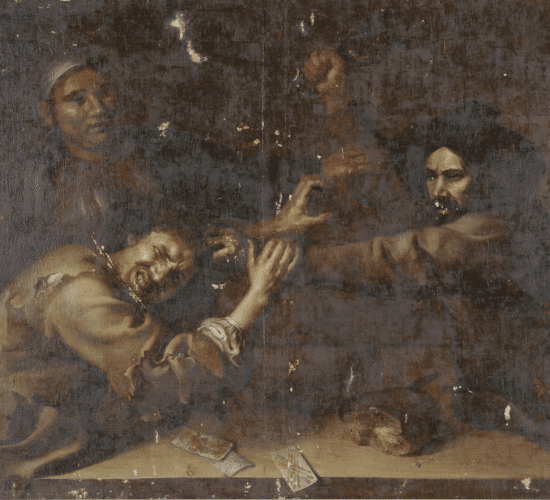The Painting during the Occupation
A.C.N. van der Sloot
On 24 July 1945, the military authorities in the Netherlands promulgated a regulation stipulating that everyone was obliged to declare: all art treasures, antiquities and libraries that came into the possession of the enemy during the enemy occupation. The response of the art collector and architect A.C.N. van der Sloot (1895-1965) to this was, for example, to submit a declaration to the Stichting Nederlands Kunstbezit [Netherlands Art Property Foundation, SNK] about a painting by, among others, ‘Ribera’, entitled Vechtpartij [Fight].
Van der Sloot traded in antiques and art on a small scale. No indications were found during the investigation that he bought and sold art as an occupation. According to a post-war report from the American Art Looting Investigation Unit, during the occupation Van der Sloot had contact with Walter Andreas Hofer, Hermann Göring’s representative, to whom he wanted to offer paintings. Van der Sloot supposedly told Hofer that his business dealings were extremely successful thanks to the Germans. In 1941 Van der Sloot also tried to sell paintings to Hans Posse, director of the Staatsgalerie Dresden and head of the Sonderauftrag Linz [Special Mission Linz]. Van der Sloot established contact with him through Dr G. Vogeler, a doctor who during the occupation worked in the head office of the Soziale Verwaltung [Social Administration] under the Reichskommissar [Reich Commissioner] and to whom Van der Sloot rented a room in his home. Van der Sloot wrote the following in a letter Posse:
I am an architect by profession and work for the German Wehrmacht, so I am not a professional dealer.
On 18 February 1946 Van der Sloot completed an SNK declaration form concerning the current NK 3533. On the form he stated that he had bought the Painting, to which he gave the name Vechtpartij [Fight], from ‘Meier van Praag Spiegelstraat Amsterdam’. In an undated letter to the SNK, Van der Sloot furthermore stated that he had bought the Painting ‘in 1941 from Meyer van Praag, residing in Spiegelstraat in Amsterdam’. According to a note added later to the declaration form, Van der Sloot made this purchase in October 1941 and paid 760 guilders for it. Documentation dated 1960 about the recovery and return of the Fighting Card Players from Germany to the Netherlands includes the following about the sale by Meijer van Praag:
As justification, it [the Dutch embassy] submits that Mr A.C.N. van der Sloot bought the painting in question in October 1941 from Mr Meijer van Praag, Amsterdam, Spiegelstraat. He was in need of money at the time because he had to hand over his cash etc. to the German authorities as a result of the occupying forces’ measures against the Jewish population.
It is not clear which person is being referred to in the post-war declarations by Van der Sloot to the SNK about the ‘Meier’ or ‘Meyer’ van Praag residing in Spiegelstraat from whom he supposedly bought the Painting in 1941. At the time the painting was sold, Meijer was not living in Amsterdam, but had already been residing at Baandert 22E in Sittard for two years. His brother Sadok did live in Amsterdam, however, and moreover had an ‘antiques shop’ in Nieuwe Spiegelstraat. It is possible that Van der Sloot, nearly five years later, was mistaken about the owner’s first name. It is remarkable, though, that he knew the name of the owner’s brother living in Limburg and referred to it. A more likely scenario is the possibility that Van der Sloot actually referred to Meijer, who had sold the painting in or through his brother Sadok’s art gallery.
